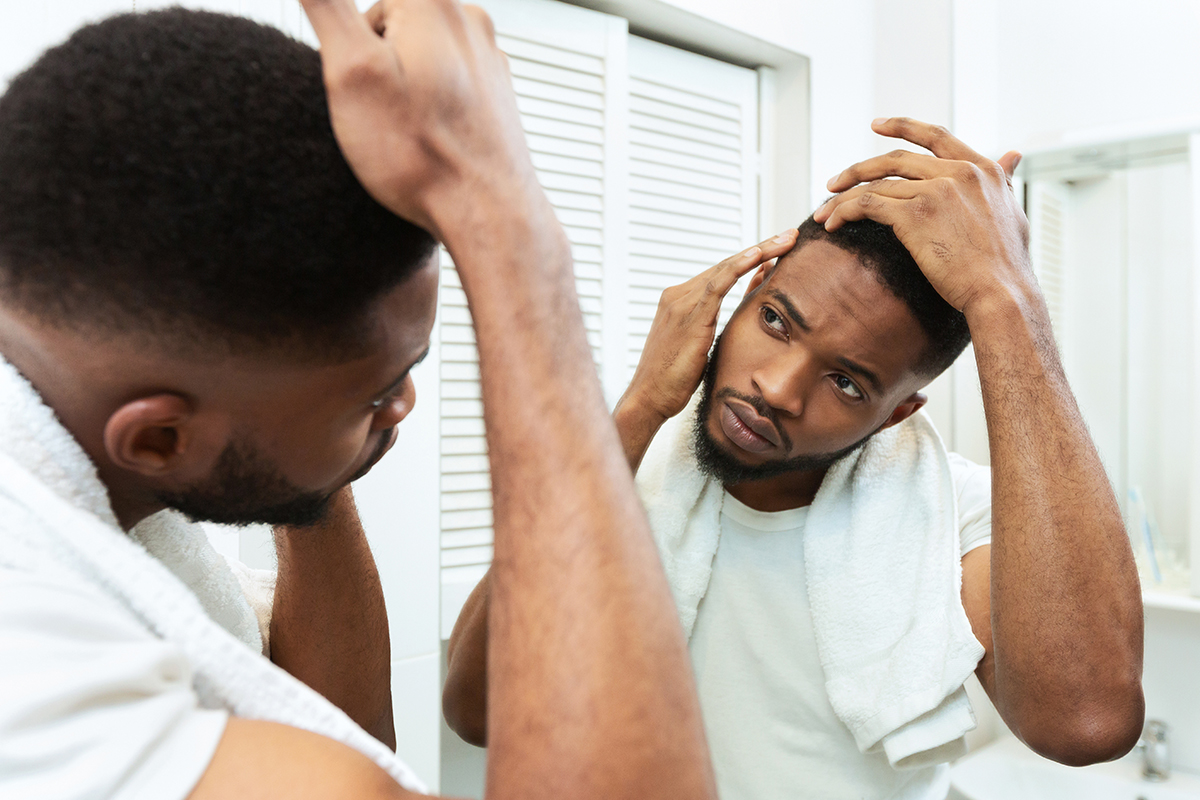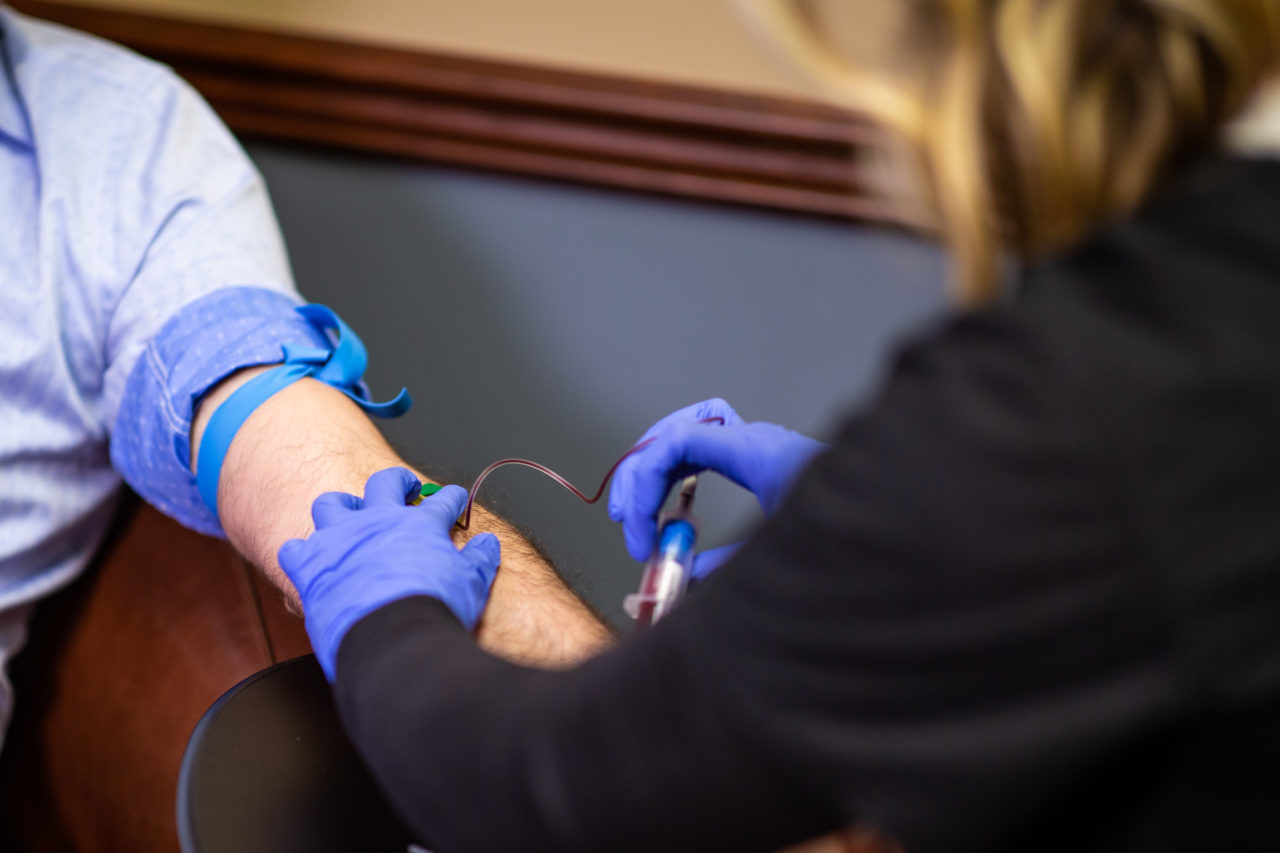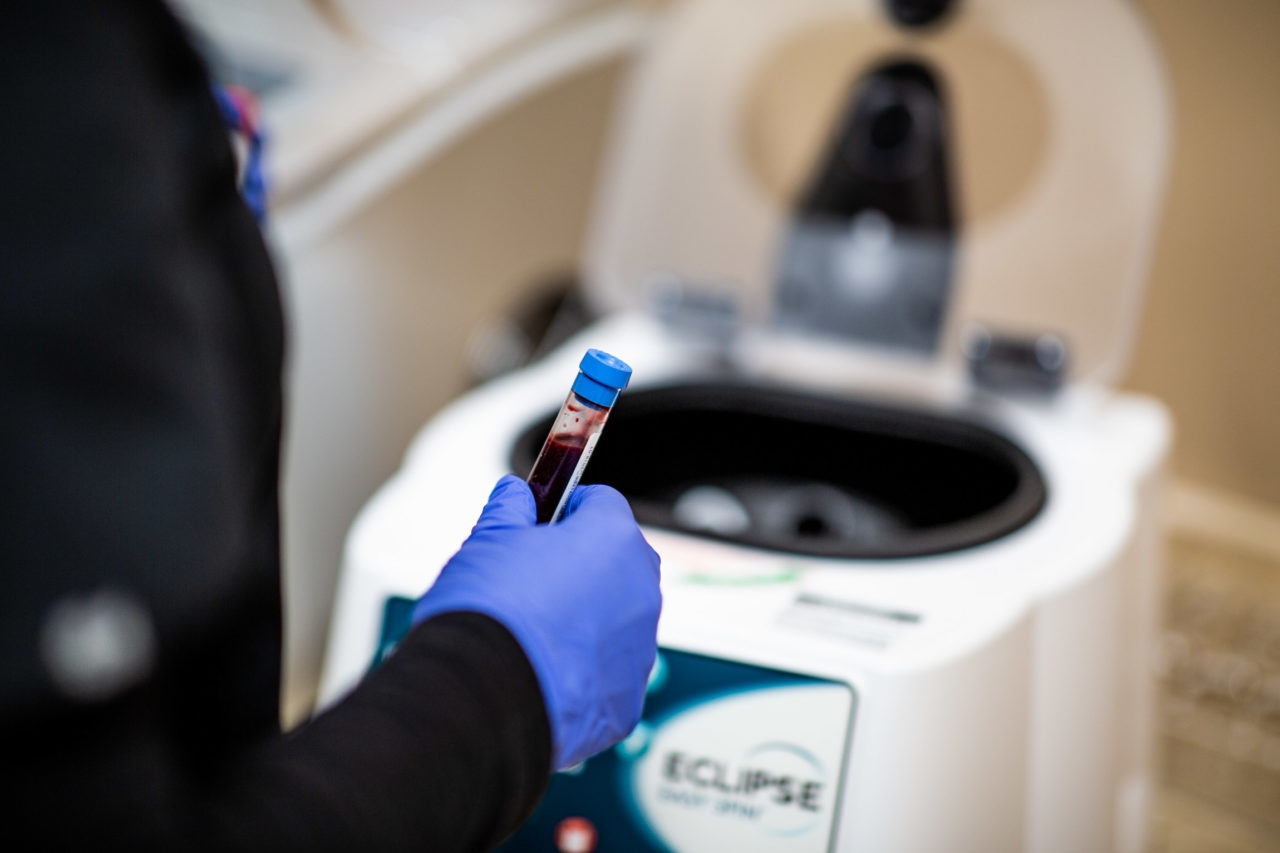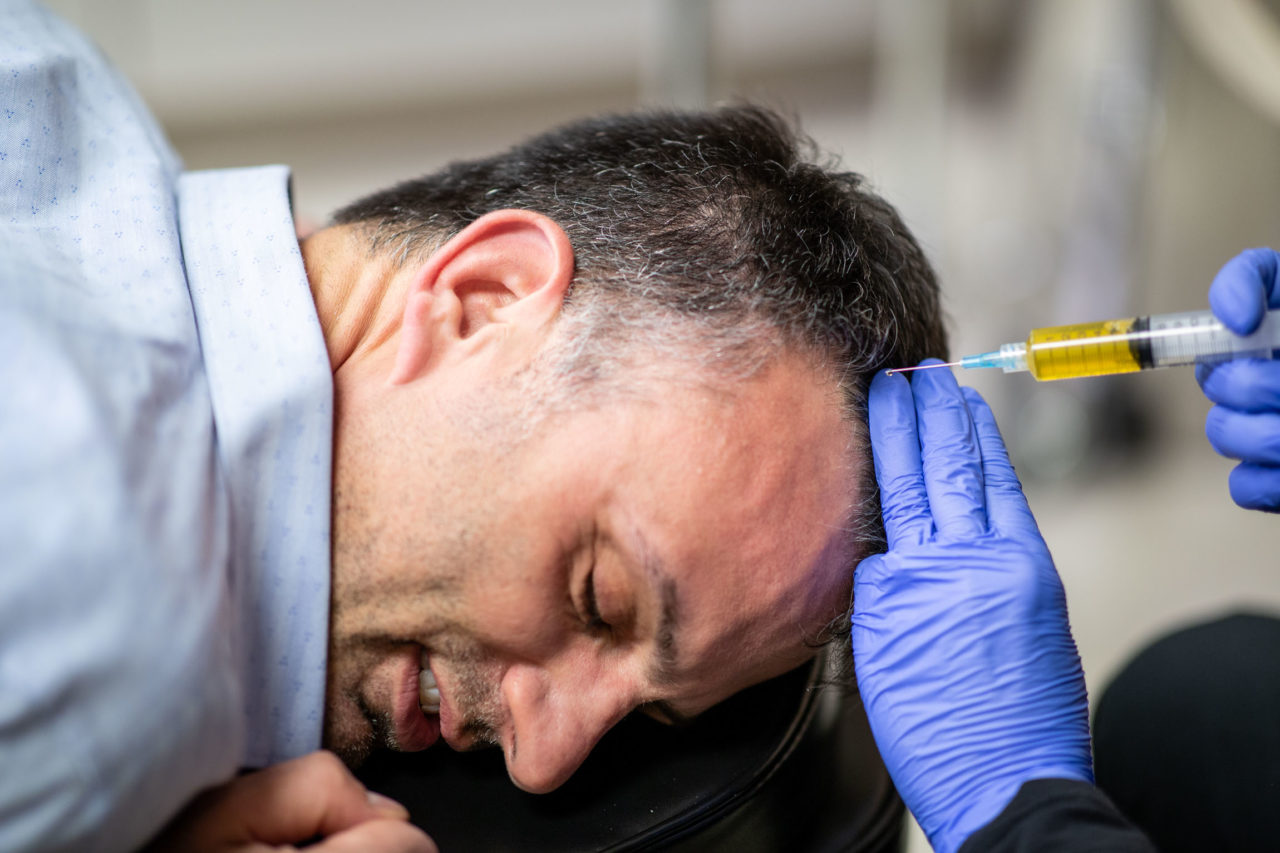
For many people, hair loss can majorly affect self esteem and confidence. As the years pass, you may notice your hair isn’t as full as it once was. But with hair restoration in Rochester, you can finally break the hair loss cycle and achieve real hair growth, all without dealing with the hassle of an invasive surgery from a hair surgeon near you.
At Envision Aesthetics, many of our patients come to us wondering how they can take control of their hair loss for thicker, fuller hair. For more information, read our in-depth guide for everything you should know about hair restoration in Rochester.
The science behind hair
Believe it or not, there’s a lot more to hair than it simply growing from your scalp. So let’s start from the beginning. By time a fetus reaches about 22 weeks, it has already formed all of its hair follicles (a total of about one million on the head!).
Here’s the thing: during this period, this the most hair follicles anyone will have; you won’t grow anymore later on. That means hair naturally thins as you age. Plus, you have to take into account that your scalp also expands. So if you noticed you had thicker hair as a child, that’s just because hair was concentrated in a smaller area.
Hair anatomy
There are two main parts that make up your hair—the follicle and the shaft. The follicle lies inside of your skin, while the shaft is the part that you see.
The hair follicle
Even though you can’t see your hair follicle, it’s the only living part of your hair (yep, the rest of your hair is technically “dead”). It’s a tunnel-like structure that sits in your epidermis (upper layer of skin) and stretches into the dermis (bottom layer of skin).
There are two sheaths, inner and outer, that protect your hair follicle. Without them, who knows what would happen?
P.S. We do… you wouldn’t be able to grow your hair properly.
The hair shaft
The hair shaft is made up of keratin (a protein used to strengthen your hair and nails) and has three layers: the cuticle, cortex, and a medulla in coarser hair. These layers help protect your hair shaft against damage and allow it to stretch without breaking.

The hair growth cycle
Understanding the hair growth cycle is the first step to understanding how hair restoration in Rochester works. Here’s why: hair restoration depends on your natural hair growth cycle, and it could also be a big reason why you’re experiencing hair loss in the first place.
The hair growth cycle includes three phases:
- Anagen
- Catagen
- Telogen
Phase 1: Anagen
Anagen is the active growing phase where the hair bulb is intact. Hair grows in both directions—upward and downward. During early anagen, the bulb is closest to your skin’s surface and contains an abundance of melanin (pigment). This phase makes hair restoration in Rochester the most effective.
Phase 2: Catagen
Catagen is a brief intermediate phase between anagen and telogen. Basically, it’s a regression period when the hair stops growing but hasn’t started shedding. Your body also absorbs the lower third of the follicle.
Phase 3: Telogen
Telogen is the resting phase. But just because it’s “resting” doesn’t mean your hair falls out right away. First, the hair follicle connects to the hair shaft, forming “club hair.” If you notice a strand of hair with a bulb on the root end, that’s club hair. The bulb keeps the hair shaft in the scalp until it finally sheds, and the process starts all over again.
When something disrupts the cycle, or you have damaged hair follicles, thinning hair and balding can occur. Keep in mind that all hair isn’t in the same phase at once. Just imagine if it were—you’d have a ton of hair one moment, then be completely bald the next.
The ins and outs of hair loss
Alright, so we’ve covered some hair basics, so let’s move on to why people lose hair. The technical term for hair loss is alopecia. Despite what you may think, alopecia doesn’t just describe one condition; it’s a term that describes all hair loss. Hair loss can happen anywhere on the body, but for most, the area of concern is the scalp.
Factors behind hair loss
The causes behind hair loss often depend on the type of hair loss you’re experiencing (we’ll go into more detail later). These factors include:
Genetics: Unfortunately, most hair loss stems from genetics, meaning there’s really nothing you can do about it without hair restoration in Rochester. Your heredity determines where and how soon you’ll start losing hair.
Hormonal changes: Hormones play a huge role in a lot of your bodily functions, so it’s no wonder that even the slightest change can affect hair growth. For example, during pregnancy women may have thicker hair, but after birth, hair may seem to fall out at once. Other hormonal factors include menopause and thyroid disorders.
Medical conditions: Certain medical conditions can cause temporary or permanent hair loss. This includes ringworms, trichotillomania (hair-pulling disorder), and conditions that cause patchiness.
Medications: Along with medical conditions, medications can also cause your hair to thin or even bald. Certain medications for acne, blood pressure, depression, and more may disrupt your natural hair growth cycle.
Stress: Whether physical or mental, stress can temporarily cause hair loss. Usually once the body relaxes, hair begins to regrow.
Tight hairstyles: Hairstyles like tight ponytails and braids tug at the scalp. At times they are fine, but if you’re consistently wearing tight styles, your hair may start thinning. This is especially true around the hairline.

Hair loss symptoms
Without understanding symptoms, many people come to Envision Aesthetics mistaking their natural shedding for hair loss. We don’t want you to stress over nothing and cause actual hair loss. Instead, here are a few hair loss symptoms to help.
Symptom #1: Gradual thinning on the top of your head
Gradual thinning is the most common type of hair loss in both men and women. This is usually a sign of aging and is mainly caused by genetics.
Symptom #2: Patchy and/or circular bald spots
You’ll notice smooth, bald spots throughout your head. Patchy spots typically occur on the scalp, but in some instances, you may notice it on your eyebrows or facial hair.
Symptom #3: Hair suddenly loosens
Loose hair is often a result of stress or a traumatic event. When you wash, brush, or comb your hair, you may notice more hair falling out than usual.
Symptom #4: Total body hair loss
Losing hair all over your hair and body usually correlates with a medical treatment such as chemotherapy or radiation.
Symptom #5: Scaly patches throughout scalp
More than likely, this is a sign that you have ringworm, especially if it comes with broken hair, redness, swelling, and oozing.
Types of hair loss
Remember, alopecia describes all types of hair loss. For the sake of this blog, we won’t go through all of them (you’d be here a while!), but we will go through the most common types of hair loss men and women experience.
Androgenetic alopecia
Androgenetic alopecia is the most common type of hair loss. In the U.S. alone, it affects more than 50 million men and 30 million women, and it’s completely genetic. Androgenetic alopecia is also called male pattern hair loss and female pattern hair loss.
Male pattern hair loss
For men, hair loss can begin any time after puberty and accounts for more than 95% of hair loss in men. By age 35, two-thirds of men have experienced some kind of hair loss, and after 50, that number jumps to an astonishing 85%. All this goes to show that if you suffer from male pattern hair loss, it’s not only normal, it’s extremely common.
Hair loss usually begins around the hairline and the top of the head. Without hair restoration in Rochester, many men with male pattern hair loss end up going completely bald.
Female pattern hair loss
Although female pattern hair loss doesn’t usually lead to complete balding, it does cause the hair to thin over time. Instead of the hairline receding like with men, women usually notice overall thinning throughout the scalp.
Telogen effluvium
Telogen effluvium is the second most common type of hair loss. It’s marked by large amounts of hair entering the resting phase at once without reentering the growing phase. As a result, hair sheds (could be around 300 to 500 follicles a day) but doesn’t grow back.
A medical condition or event usually triggers this type of hair loss. These include:
• Pregnancy
• Thyroid conditions
• Surgery
• Fever
• Vitamin and mineral deficiencies
For most people, telogen effluvium appears three months after medical changes. If the condition is temporary (like a fever), hair loss goes away. Telogen effluvium becomes chronic after six or more months with no change.
Hair shaft abnormalities
When we say hair shaft abnormalities, we mean this is in a very general way. There are a variety of conditions and other factors that can cause the hair shaft to become weak and thin. Because of this, instead of breaking at the root, hair breaks somewhere on the shaft. Not only does this lead to hair thinning, it can also cause short, brittle hairs.
Trichotillomania: People diagnosed with trichotillomania constantly pull and tug at their hair. Once the pulling stops, hair grows back, but treatment often requires psychotherapy and hair restoration treatments.
Traction alopecia: Traction alopecia is usually the result of tight hairstyles such as braids and ponytails. If you notice your hairline thinning, take a break from those hairstyles to give your hair a breather.
Non-surgical treatment for hair restoration in Rochester
For those looking to treat hair loss without going under the knife, our team at Envision Aesthetics have found a non-surgical hair restoration treatment that stands above the rest: platelet rich plasma.
The biggest bonus? Platelet rich plasma (PRP) comes from your own body, so you don’t have to worry about rejecting the treatment or having an allergic reaction.

Okay, so what is PRP?
PRP is one of the most advanced, natural ways to regenerate and accelerate tissue repair. It’s produced by your own blood, which is composed of plasma and blood cells. Plasma is the liquid that circulates blood cells, and within plasma are platelets that cause the blood clots that help with wound healing. If you’ve ever noticed that yellow goo from a healing scab—that’s platelet rich plasma.
Other than fast healing, PRP has major growth factors that can enhance the functions of other cells it comes in contact with. The great thing about PRP is that it can be isolated from your blood and injected into other parts of your body, giving you tons of restoration benefits. As a result, wherever PRP works its magic, cellular growth, formation of new blood vessels, and collagen production follows.
Because of this, medical professionals use PRP across different medical fields, including dermatology, sports medicine, orthopedics, and yes, even for hair restoration.
How does PRP compare to other treatments?
Unlike other hair restoration treatments, PRP comes from your own body, making it more natural than its alternatives. As of now, the main alternatives for PRP are medications and hair transplant surgery.
Prescription medications
There are only two FDA-approved medications to treat hair loss: finasteride and minoxidil. Steer clear of any other medication that claims to treat balding or thinning hair. For one, they probably won’t work, and secondly, they could do more harm than good.
With both finasteride and minoxidil, you have to take them on a regular basis, and results tend to be inconsistent. Plus, let’s talk about side effects for a moment. Side effects of minoxidil include dryness and itchy scalp, which may lead to itchiness and redness. Finasteride can cause sexual dysfunction in men.
Hair transplant surgery
Getting a hair transplant is an effective way to treat hair loss, but it’s also an invasive surgery. During the procedure, a doctor will cut your scalp to implant new hair, meaning you can for sure expect downtime. Plus, most doctors will only perform a hair transplant on severely balding patients. People with thinning hair or minor patches aren’t usually a good candidate.
On the other hand PRP for hair loss only comes with 0 to 5 days of downtime, and this type of hair restoration in Rochester works for a variety of people, no matter the severity.

What to expect when getting PRP for hair loss
The PRP process is fairly quick, easy, and comes with minimal pain. Keep in mind that before you go to an appointment, avoid taking NSAIDS (Ibuprofen, Aleve, Motrin, Naproxen, etc.) You’ll also want to avoid certain nutritional supplements such as vitamin E, vitamin A, flax oil, garlic, turmeric, and other anti-inflammatory substances. If you can, stay away from alcohol and tobacco for a week before getting hair restoration in Rochester.
Step One: Draw blood
When you come in for your appointment, the first thing your provider will do is draw your blood. Remember, platelet-rich plasma is part of your blood. You feel a slight prick from the needle, but for most people there’s no pain.
Step Two: Isolate the PRP
Next, it’s time to isolate the PRP from your blood. This is done with a machine called a centrifuge. Blood runs through the centrifuge, effectively separating PRP from red blood cells.
Step Three: Inject the PRP
Once separated, your provider will transfer the PRP into syringes to inject it into your scalp. The amount of injections along with where you’ll get them depends on your specific needs.
As PRP replenishes your scalp with growth factors, you’ll soon notice fuller, thicker hair that is 100% your own.
Schedule an appointment with Envision Aesthetics
Don’t settle for just any hair restoration in Rochester, you deserve real results with PRP for hair loss. At Envision Aesthetics, our team will work with to ensure that you look and feel better.